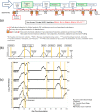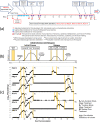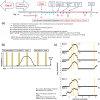MaHPIC malaria systems biology data from Plasmodium cynomolgi sporozoite longitudinal infections in macaques
- PMID: 36433985
- PMCID: PMC9700667
- DOI: 10.1038/s41597-022-01755-y
MaHPIC malaria systems biology data from Plasmodium cynomolgi sporozoite longitudinal infections in macaques
Abstract
Plasmodium cynomolgi causes zoonotic malarial infections in Southeast Asia and this parasite species is important as a model for Plasmodium vivax and Plasmodium ovale. Each of these species produces hypnozoites in the liver, which can cause relapsing infections in the blood. Here we present methods and data generated from iterative longitudinal systems biology infection experiments designed and performed by the Malaria Host-Pathogen Interaction Center (MaHPIC) to delve deeper into the biology, pathogenesis, and immune responses of P. cynomolgi in the Macaca mulatta host. Infections were initiated by sporozoite inoculation. Blood and bone marrow samples were collected at defined timepoints for biological and computational experiments and integrative analyses revolving around primary illness, relapse illness, and subsequent disease and immune response patterns. Parasitological, clinical, haematological, immune response, and -omic datasets (transcriptomics, proteomics, metabolomics, and lipidomics) including metadata and computational results have been deposited in public repositories. The scope and depth of these datasets are unprecedented in studies of malaria, and they are projected to be a F.A.I.R., reliable data resource for decades.
© 2022. The Author(s).
Conflict of interest statement
F.E-H.L is the founder of Micro-Bplex, Inc. F.E-H.L serves on the scientific board of Be Biopharma, a recipient of grants from the BMGF and Genentech, Inc.
Figures







Similar articles
-
Plasmodium cynomolgi: potential emergence of new zoonotic malaria in Southeast Asia.Parasit Vectors. 2025 Apr 23;18(1):151. doi: 10.1186/s13071-025-06784-1. Parasit Vectors. 2025. PMID: 40270022 Free PMC article. Review.
-
Plasmodium cynomolgi infections in rhesus macaques display clinical and parasitological features pertinent to modelling vivax malaria pathology and relapse infections.Malar J. 2016 Sep 2;15(1):451. doi: 10.1186/s12936-016-1480-6. Malar J. 2016. PMID: 27590312 Free PMC article.
-
A model of Plasmodium vivax concealment based on Plasmodium cynomolgi infections in Macaca mulatta.Malar J. 2017 Sep 18;16(1):375. doi: 10.1186/s12936-017-2008-4. Malar J. 2017. PMID: 28923058 Free PMC article.
-
Superior protection in a relapsing Plasmodium cynomolgi rhesus macaque model by a chemoprophylaxis with sporozoite immunization regimen with atovaquone-proguanil followed by primaquine.Malar J. 2024 Apr 17;23(1):106. doi: 10.1186/s12936-024-04933-y. Malar J. 2024. PMID: 38632607 Free PMC article.
-
Systems biology of malaria explored with nonhuman primates.Malar J. 2022 Jun 7;21(1):177. doi: 10.1186/s12936-022-04199-2. Malar J. 2022. PMID: 35672852 Free PMC article. Review.
Cited by
-
Malaria disrupts the rhesus macaque gut microbiome.Front Cell Infect Microbiol. 2023 Jan 13;12:1058926. doi: 10.3389/fcimb.2022.1058926. eCollection 2022. Front Cell Infect Microbiol. 2023. PMID: 36710962 Free PMC article.
-
Plasmodium cynomolgi: potential emergence of new zoonotic malaria in Southeast Asia.Parasit Vectors. 2025 Apr 23;18(1):151. doi: 10.1186/s13071-025-06784-1. Parasit Vectors. 2025. PMID: 40270022 Free PMC article. Review.
References
-
- Antinori, S. et al. Non-human primate and human malaria: past, present and future. J Travel Med28, 10.1093/jtm/taab036 (2021). - PubMed
Publication types
MeSH terms
Grants and funding
LinkOut - more resources
Full Text Sources
Medical

